
|

|
| Use the text links for more information! |
| Not so Fine
The Prospect Inn occupies a site that has boasted an Inn since 1830. The building seen today was originally called the
Fountain Inn. This Inn occupied the end of the Quay House and later absorbed the adjacent Rose Cottage as part of it's
premises. The pub sign states that the place is an original C17th Inn, however this version of the Quay House was only
built in 1676, so someone is being slightly economical with the truth.
Many scenes were shot in the upper rooms of this pub and featured heavily in the BBC Television series, The Onedin Line.
You'll have heard series' title track, from the ballet "Spartacus" by the Russian composer, Aram Khatchaturian. Quite
fancied Elizabeth Onedin myself, picture right.
More haunting still
Just outside the pub there are more ghosts. Sea shanties are said to be whistled by a young seaman, the sounds coming from
beneath the rafters of the cafe in the antique shop opposite the pub. This open-sided Fish transit shed houses the 'Kings
Beam', a cast iron structure dated 1838 used by customs for suspending weighing scales. The beam and shed was made by a local
company, Bodleys in 1838, part of this structure can still be seen. The shed was used for covered storage of cargoes.
It was restored in 1988. The antiques shop and cafe used to be the fish market. |
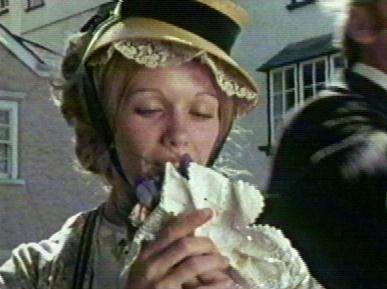 |
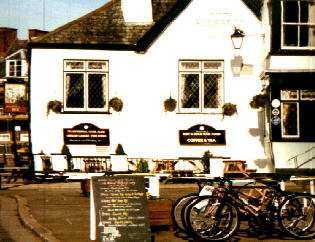 |
 |
| Quay House Turn right out of the pub. The Quay House which houses an interpretation centre was restored in 1987 when much of it's past history was discovered. A length of 17th century quay wall with iron moorings can be seen outside the windows, most of the oak timbers are original. Ten bays formerly extended to the far end of the prospect Inn and the canopy protected the boats as they unloaded directly into the transit shed 2. By 1720, this dock had been in-filled with the quayside taking on it's current geometry. Click here for further information on the development and geometry of the quayside. |
Wharfinger
The Wharfingers Office is tagged onto the end of the Quay House, and was built in 1778 to house the City's harbour
master. It did house the Exeter Quay and Canal Trust from 1981 formed to develop the Quay and Canal area. Take a look at
this pop up, Quay Map
Riva is located next door to the left is an old bonded warehouse
once owned by Carr and Quick Ltd., who were Exeter brewers and were located in Okehampton Street. They owned the
West of England Brewery. The store was converted to a nightclub in the 1980's and became this pub / club in 2006.
You may want to nip in here for a pint. Sometimes there is an entrance fee.
|
| Custom House
Further to the right as you exit the pub is the old Custom House which is also said to be haunted by two horses, a
flat wagon and a driver. They are seen to travel along the cobbled street in front of the Custom House and the disappear
inside. Exactly what they're doing going in there is open to debate however a fifth city gate had been cut into the
Roman Wall in 1566 to allow better access to the quay, so maybe they were on their way through this gate. The gate was
called Watergate and was later sealed. The exit old outfall of Coombe Brook (before it was diverted below street level),
can also be seen behind the Custom House. Watergate was close to this outfall. The Custom House was built in 1685 and was
used by the Customs and Excise for boats mooring at the quayside and in the canal basin. Customs and Excise vacated the
building in 1989. This is one of the earliest brick buildings in the city, originally, the arches that are now bricked
in were open and the ground floor was like an arcade suiting easy stowage. These were filled in as trade increased and
more storage space was required. The building was restored in 1992. The coat of arms in the central apex at the front of
the building, is that of George IV, and is dated 1820, the year he
ascended the throne. This was restored in 1988.
During financial years 2001 and 2002, the custom House has cost Exeter City Council and English Heritage £250,000
to maintain. It is a grade one listed building looking for a use. So far ideas have included a restaurant and a casino.
Personally I think it would make an excellent casino. |
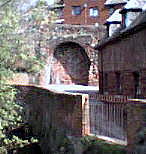 |
| Cannon and Sculpture
The cannons outside the Custom House reached Exeter in 1819 having been sent back from the
Penninsula War (1808-1814) as surplus to requirements.
They were cast in Glasgow and had been buried in the Quay as bollards until 1983 when two where restored and mounted on the
gun carriages. There should be another one of these kicking around somewhere! To the left of the Custom House is Quayside
Crafts. This building was formerly a bonded store and was built in C17th and used by J.J Norman for many years.
Outside the crafts shop is a sculpture by Roger Dean, that was placed in 1990. It is based on an armillary sphere, an
ancient astronomical instrument depicting the heavens and the movement of celestial bodies. Armillary spheres date back
to the mid C3rd BC.
|
| Cross the river using Cricklepit Bridge and head off to the Malthouse which is the red sandstone and breccia building you can see from the bridge on your right. An alternative would be to use Butts Ferry and head into Bar Venezia in the corner of Piazza Terracina. You may have used Mallison Bridge (over the leat), this was opened on 19th September 1984 as part of the quayside improvement scheme. |
| Malt
The Harvester Malthouse, (formerley the Malthouse) changed hands in 2007 and the
improvement in service and quality is phenominal.
The malting of barley took place here from 1791
until September 1949.
The building first appeared in 1789 as the New Brewery. The curved north east wall reflects the
shape of the original tenement plot on which it was built. The brewery was expanded to house a malthouse in 1791 and in
1876 two malting kilns were added one of which was replaced in 1900 when three larger malting kilns were added.
The malt will have originally been supplied to the many breweries of Exeter, however it eventually only supplied the
City Brewery who purchased this brewery in 1833 and which stopped brewing in 1956. Brewing on this site had ceased by
1850, the building better geared to malt production than that of beer.
The business was owned by Hore & Sons (1823) and Hore & Salter (1830). Salter went on to become a partner in
City Brewery when they bought it in 1833.
|
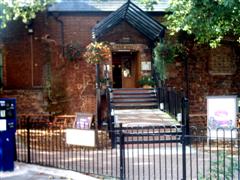
Another brewery close by was, The Wellpark Brewery in Willeys Avenue,
now converted to flats. This brewery ceased brewing after the WW2.
Once you've finished sup up and head towards the Piazza Terracina
(opened 6th July 1996), back down river.
Look to the City skyline on your left, over the river, you'll see
'New Theatre', built in 1913 and was at one time the Holy Trinity
Church Hall, before it closed in 1969, the building now houses the Cygnet Theatre.
|
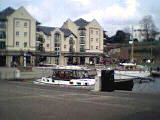 |
Haven
On your way to the Piazza you'll pass the award winning Haven Banks residential scheme which was started in 1988.
The council stipulated that any design would have to be in-keeping with the warehouses on the Quay and not any taller.
I can't quite see how they are in-keeping but they won awards anyway and they're far better than what was here before.
|
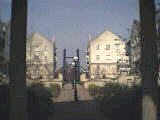 |